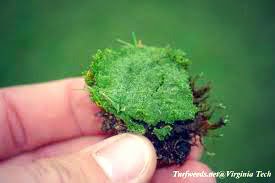Why is there moss in my lawn?
What’s the Deal with Moss?
 Moss is a plant that can grow in conditions that other plants, including grasses, can’t endure. It is not a very aggressive or competitive plant, but nature seems to use it more as a filler, for thin or bare soils. So, when you ask the question “Why is there moss in my lawn?” the simple and correct answer is “because you have conditions that are making it too hard for your lawn to survive.”
Moss is a plant that can grow in conditions that other plants, including grasses, can’t endure. It is not a very aggressive or competitive plant, but nature seems to use it more as a filler, for thin or bare soils. So, when you ask the question “Why is there moss in my lawn?” the simple and correct answer is “because you have conditions that are making it too hard for your lawn to survive.”
Moss spores are in the air and only need moisture to germinate and mature. Once established, moss can be very drought tolerant. Some mosses can survive in full sun, though most prefer shade. Moss can grow on any type of soil because their shallow roots simply hold the moss there without drawing nutrients from the soil. They get some nutrients from water, but mostly they make their own food through photosynthesis.
The biggest myth about moss
 Ask most gardeners what can be done about moss and they will tell you that that the soil is too acidic (low pH) and it needs to be sweetened with lime (calcium). This is false! As we said above, moss grows in any type of soil – acidic, alkaline, and sometimes on pure rock. The only reason that lime sometimes helps lawns squeeze out moss is when the soil actually is too acidic for the grass to grow properly and it is thinning out. Adding lime in this case, would raise the pH and improve the health of the grass. So, as you can see, the real cause of the moss here is the poor health of the grass.
Ask most gardeners what can be done about moss and they will tell you that that the soil is too acidic (low pH) and it needs to be sweetened with lime (calcium). This is false! As we said above, moss grows in any type of soil – acidic, alkaline, and sometimes on pure rock. The only reason that lime sometimes helps lawns squeeze out moss is when the soil actually is too acidic for the grass to grow properly and it is thinning out. Adding lime in this case, would raise the pH and improve the health of the grass. So, as you can see, the real cause of the moss here is the poor health of the grass.
Weak Grass/Moss Causing Conditions
Here are the major reasons for moss on lawns:
- Too much moisture. Soggy soils, often clay types, drown grass roots but shallow rooted moss can tolerate and thrive in wet soils.
You can improve soil drainage with Aerify Plus. - Too much shade. Grass plants needs a fair amount of sunlight for enough photosynthesis to keep them healthy. Shade tolerant varieties can withstand a little less light, but some moss varieties survive in total shade.
Trimming back the lower branches of trees can be helpful. - Clay soil/compaction. Grasses are tough plants that can grow in fairly heavy clay top soils, especially if the soil is moist. But extreme compaction or denser clays are almost impregnable. Moss has no problem growing on this dense clay.
The best product for improving clay soil and compaction is Aerify Plus. - Drought/ Dry soil. This might sound counter-intuitive, since moss likes moisture, but here is what can happen. When high clay content soils dry out during a drought or normal summer conditions, the loss of moisture causes the soil to actually shrink, which turns it tighter and denser. This can tear and damage grass roots and make it impossible for them to get to the nutrients and water. When the lawn finally begins to receive rain or water, opportunistic moss spores germinate easily, since the grass is not healthy enough to compete. Last summer we experienced a major drought in the North East, and this spring we are finding more moss than ever before.
Check out our blog post on How to Water Your Lawn for more tips. - Tree Roots. Tree roots can cause moss in a couple of ways. 1. The larger roots that grow close to the soil surface do not give the grass enough soil to dig into. Hence, moss develops and grows on top of these roots. When lawns are not watered deeply, the finer and even microscopic feeder roots of the tree can move upwards into the topsoil and compete with the grass for both water and space. This weakens the grass and permits moss to come in. This also can happen around shrubs that border the lawn, especially evergreens.
- Poor Mowing/Trimming. Poor mowing, mostly too short, can cause your lawn to change from one grass type to a less desirable type. In cases of very short mowing, or even scalping, no grass can survive. Usually you end up with low growing weeds or moss. The same holds true for those who use their “weed whackers” to trim the edges of the grass close to the ground. The short grass does not allow food production (photosynthesis) and has no chance for survival.
Check back soon for a blog post on How To Properly Mow Your Lawn! - Very Acidic or Very Alkaline Soil. As mentioned above, this is not the major cause of moss on most lawns. In extreme acid or alkaline conditions nutrients will lock up and become unavailable to the grass. This causes unhealthy grass and allows moss to fill in.
If the pH of your lawn is extremely low you can balance it with Liquid Lime.
To conclude, if you have moss growing in your lawn, look for the conditions that may be causing or contributing to it. Change what you can, and if you can’t change the conditions, try to appreciate the fact that this green carpet is covering what may otherwise be bare soil! 🙂
If you have any other questions about moss, please feel free to drop us a line at [email protected]!


